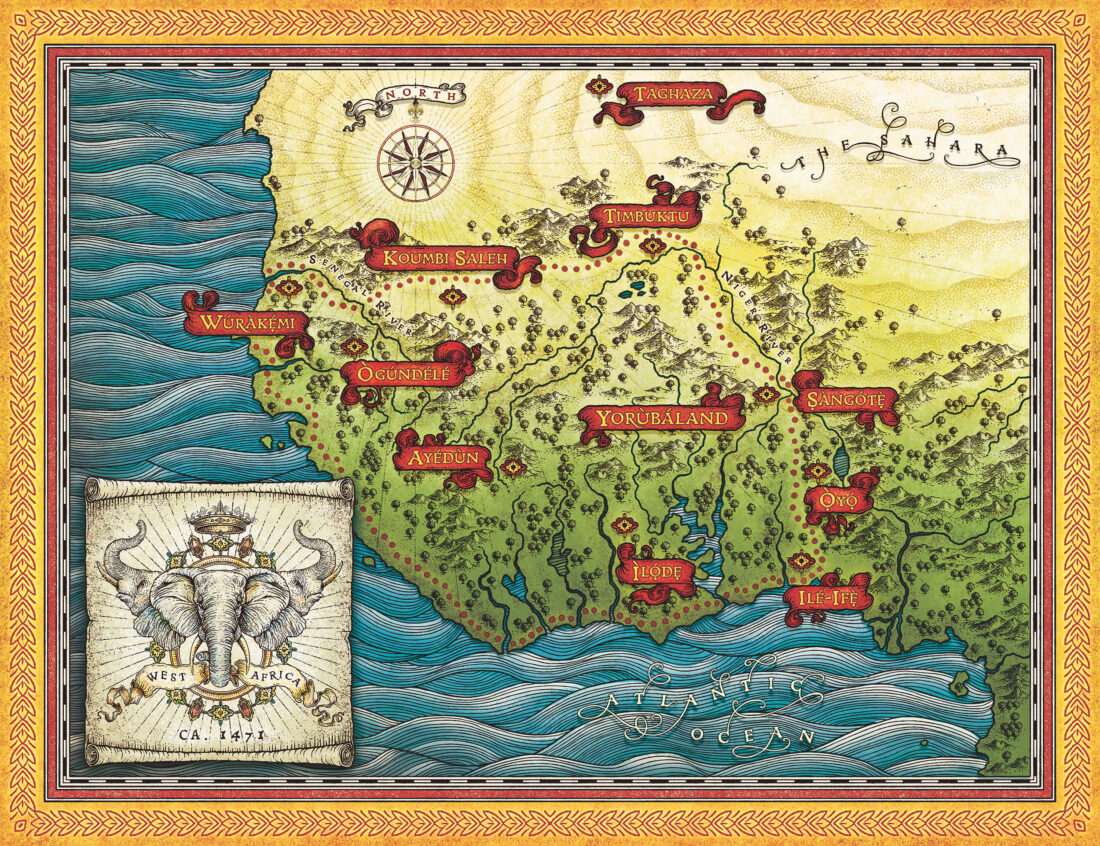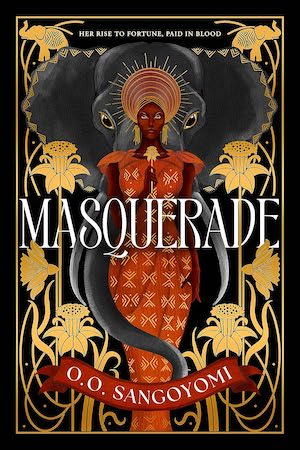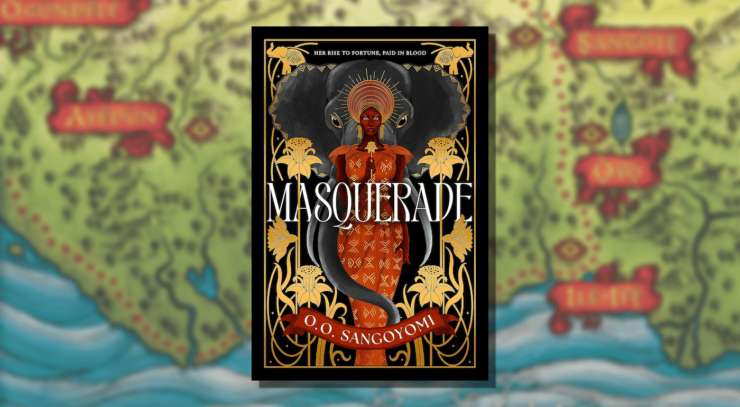A young Yorùbá woman rises from social pariah to power in a reimagining of pre-colonial West Africa…
We’re thrilled to share the map from O.O. Sangoyomi’s debut novel, Masquerade—publishing July 2nd with Forge Books. Get a look at the full map by artist Virginia Allyn below, along with a note from the author.
Òdòdó’s hometown of Timbuktu has been conquered by the warrior king of Yorùbáland. Already shunned as social pariahs, living conditions for Òdòdó and the other women in her blacksmith guild grow even worse under Yorùbá rule.
Then Òdòdó is abducted. She is whisked across the Sahara to the capital city of Ṣangote, where she is shocked to discover that her kidnapper is none other than the vagrant who had visited her guild just days prior. But now that he is swathed in riches rather than rags, Òdòdó realizes he is not a vagrant at all; he is the warrior king, and he has chosen her to be his wife.
In a sudden change of fortune, Òdòdó soars to the very heights of society. But after a lifetime of subjugation, the power that saturates this world of battle and political savvy becomes too enticing to resist. As tensions with rival states grow, revealing elaborate schemes and enemies hidden in plain sight, Òdòdó must defy the cruel king she has been forced to wed by re-forging the shaky loyalties of the court in her favor, or risk losing everything—including her life.
Loosely based on the myth of Persephone, O.O. Sangoyomi’s Masquerade takes you on a journey of epic power struggles and political intrigue that turn an entire region on its head.

The Yorùbá are one of the oldest and most notable inhabitants of West Africa. With a long history of hegemonizing neighboring tribes, their influence has become so widespread that most West African tribes can point to at least one aspect of their culture or language that was directly influenced by the Yorùbá.
The premise of Masquerade takes this history of conquest and proposes a reality that extends the height of Yorùbá dominance. This is beautifully captured by the novel’s map, in which reality meets the invented. There are real cities such as Ilé-Ifẹ̀, which is regarded by the Yorùbá as the source of all civilization; Ọ̀yọ́, the seat of the Ọ̀yọ́ Empire, arguably the most significant empire in Yorùbá history; and Timbuktu, the famous trade center that for centuries was a vital hub in the Trans-Saharan trade.
There are also fictional cities that, though imagined, were placed with careful consideration for history and geography. For example, as a city that broke off from Ọ̀yọ́ to declare itself as the new seat of Yorùbáland, it only makes sense for Ṣàngótẹ̀ to not only be near Ọ̀yọ́ but also near the Niger, which grants it the same favorable commercial, agricultural, and defensive prospects that allowed Ọ̀yọ́ to be so powerful. Ìlọ́dẹ, the city of hunters, needed to be in the heart of the grasslands; Wúràkẹ́mi and Ògúndélé are placed near the gold and iron deposits that are respectively the pride of their cities.
In this alternate timeline, the borders of Yorùbáland have expanded far beyond the tropical rainforests of the south. They have enveloped Koumbi Saleh, the Ghana Empire’s former capital, and have also begun to creep northward into territories historically occupied by the Songhai and Mali Empires. Positioning Yorùbáland among these three great empires of pre-colonial West Africa establishes the supremacy of the reimagined empire in Masquerade, as well as the constant threat of opposition that comes with that ambition—a pressure that increasingly weighs on Òdódó, the novel’s main character, as she climbs her way to power.
Ultimately, the best part of this map is not its reimagined setting, nor is it the stunning designs done by Virginia Allyn, the map’s illustrator. Rather, the best part is that beneath all of that, this is simply a map of West Africa. This is not a different world; there is nothing fantastical about it. Pre-colonial Africa is largely underexplored in mainstream media, but as readers enter the world of Masquerade, this map serves as a reminder that many of the Medieval West African histories they are about to immerse themselves in were very real.
Buy the Book


Masquerade










